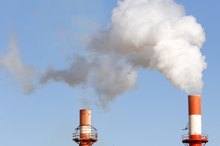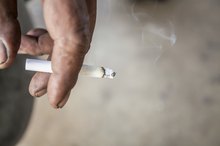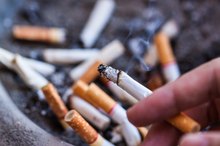The Effects of Smoking on Your Respiratory System
The major health problems caused by smoking affect the nicotine delivery system: the airways, blood vessels and lungs in the human respiratory system. During normal breathing, air is ingested through the nose or mouth and travels through the bronchial tubes to the lungs.
There, the oxygen collects in the alveoli, or air sacs, and diffuses into the bloodstream, to be pumped by the heart to the brain and body. Cigarette smoking upsets this balanced process, to the detriment of the respiratory system.
Effects on the Mouth, Larynx and Pharynx
Hot gases and particulate inhaled during cigarette smoking contact the tissue and mucous membranes that surround the mouth; larynx, or voice box; and pharynx, or throat. These areas suffer continual irritation from smoking, and tobacco users may develop symptoms such as hoarseness, coughing and wheezing due to inflammation.
As the National Institutes of Health report, cigarette smoke contains more than 60 cancer-causing compounds. The U.S. Surgeon General has linked mouth, larynx and pharynx cancers with tobacco use.
- Hot gases and particulate inhaled during cigarette smoking contact the tissue and mucous membranes that surround the mouth; larynx, or voice box; and pharynx, or throat.
Effects on the Bronchi
The Effects of Methamphetamine on Arteries & Blood Vessels
Learn More
Chemicals and particulate from tobacco use continue on to the bronchi, the airways that lead to the lungs. There, the smoke acts on the cilia, tiny hairs that sweep away debris to keep the airways clear. When damaged cilia can no longer function, excess mucus and foreign matter clog the bronchial space.
The American Lung Association (ALA) relates that symptoms of chronic bronchitis arise to compensate for this health problem. A frequent cough and expulsion of phlegm indicate this first stage of chronic obstructive pulmonary disease (COPD).
- Chemicals and particulate from tobacco use continue on to the bronchi, the airways that lead to the lungs.
- There, the smoke acts on the cilia, tiny hairs that sweep away debris to keep the airways clear.
Effects on the Lungs
The alveoli of the lungs suffer from cigarette smoking, eventually breaking down and losing their effectiveness in transferring oxygen to the blood. This second stage of COPD, emphysema, is characterized by shortness of breath and difficulty exhaling, the ALA notes. COPD restricts exercise tolerance, making everyday activities more difficult and strenuous exercise impossible for many individuals.
While COPD health problems are responsible for 92,900 annual deaths, lung cancer causes 128,900 deaths per year, according to 2008 U.S. smoking mortality data from the Centers for Disease Control and Prevention.
- The alveoli of the lungs suffer from cigarette smoking, eventually breaking down and losing their effectiveness in transferring oxygen to the blood.
- This second stage of COPD, emphysema, is characterized by shortness of breath and difficulty exhaling, the ALA notes.
Effects on the Pulmonary Blood Vessels
Three Reasons Why Smoking Should Be Banned
Learn More
Tobacco use causes atherosclerosis, or clogging of the blood vessels. When the arteries and veins between the lungs and heart are affected and high blood pressure results, the condition is called pulmonary hypertension. As the Mayo Clinic reports, this health problem can lead to arrhythmia, heart failure, blood clots and pulmonary embolism, all of which can be fatal.
Related Articles
References
- National Institutes of Health: Tobacco Carcinogenesis
- U.S. Surgeon General: 2004 Report, Respiratory System
- U.S. Surgeon General: 2004 Report, Cancer
- American Lung Association: COPD
- Mayo Clinic: Pulmonary Hypertension
- Centers for Disease Control and Prevention. Health Effects of Smoking. Updated April 28, 2020.
- Gibbons DL, Byers LA, Kurie JM. Smoking, p53 Mutation, and Lung Cancer. Mol Cancer Res. 2014;12(1):3-13. doi:10.1158/1541-7786.mcr-13-0539
- Baglietto L, Ponzi E, Haycock P, et al. DNA Methylation Changes Measured in Pre-Diagnostic Peripheral Blood Samples are Associated With Smoking and Lung Cancer Risk. Int J Cancer. 2017;140(1):50-61. doi:10.1002/ijc.30431
- Centers for Disease Control and Prevention. Fast Facts: Smoking & Tobacco Use. Updated May 21, 2020.
- Centers for Disease Control and Prevention. What Are the Risk Factors for Lung Cancer? Updated September 18, 2019.
- Centers for Disease Control and Prevention. Smoking and COPD. Updated March 23, 2020.
Writer Bio
Nancy Clarke began writing in 1988 after achieving her Bachelor of Arts in English and has edited books on medicine, diet, senior care and other health topics. Her related affiliations include work for the American Medical Association and Oregon Health Plan.









